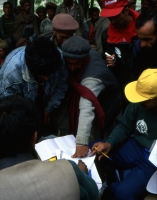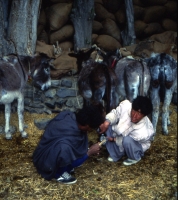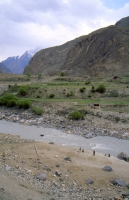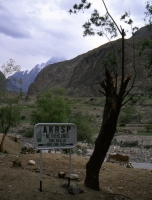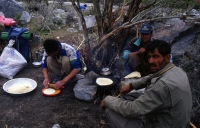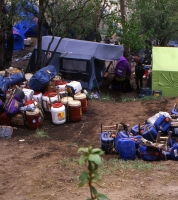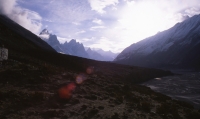Memories from a second expedition-doctor. By Wouter J.W. Beelen.
 049_Braldu Valley
049_Braldu Valley
Steep down we go into Braldu-valley. Inside the jeep I feared we were toppling over.
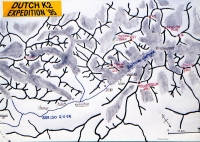 050_Chongo-K2 Walk
050_Chongo-K2 Walk
The walk leads from Chongo; beyond Payu we walk on the Baltoro Glacier, about 100 km altogether.
 051_Chongo Porters
051_Chongo Porters
Here in Chongo the porters wait to sign their contracts and receive their loads. 220 porters carry loads, another 70 carry food for the porters.
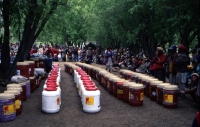 052_Chongo Loads
052_Chongo Loads
Over 7000 kilo's of gear are to be carried to K2 Basecamp. About half of it is food.
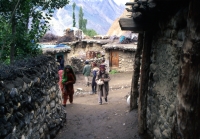 057_Askole
057_Askole
Next day we start our walk; it leads us first, after about an hour, through Askole. It is the last permanent settlement on our track. It is a small, dirty village with litlle means of making money. In Askole the women are shy and hard to get on photo.
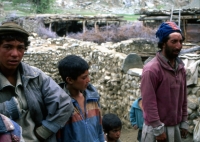 058_Askole
058_Askole
The men don't care for the camera; they hope to receive a rupee for their picture. They are not very beautiful, more like pityful.
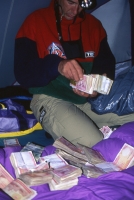 060_Korophon Rupees
060_Korophon Rupees
Ronald was a little too touchy these days, probably because of too many worries about almost everything and too little sleep. I therefore wasn't completely confident when he decided we shared tent that night. On top of everything the number of porters seemed to raise beyond all expectations; counting and recounting the money also didn't prove relaxing.
 061_Korophon
061_Korophon
The next morning I was somewhat shocked by the sudden leaving of the porters. I had to hurry; I feared getting lost in Baltoro. Ronald was busy collecting left-behind loads. Porters didn't seem to worry a lot about the expedition-gear.
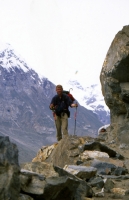 062_Korophon-Payu trail
062_Korophon-Payu trail
Back on track. Notice the umbrella; I bought that in Skardu. Thierry told me to do so. He proved right a little later.
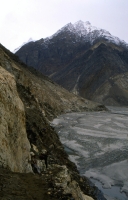 063_Dumordo Payu Peak
063_Dumordo Payu Peak
The first hurdle in sight: we had to cross the Dumordo river (coming from the left).
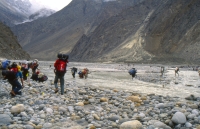 064_Dumordo Crossing
064_Dumordo Crossing
In may's mornings the stream is still relatively small, it can be crossed by wading. The water is very cold anyhow.
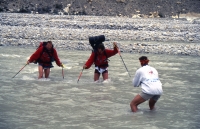 065_Dumordo Crossing
065_Dumordo Crossing
Wilco stood there filming. I hurried as fast as I could there because of the cold water.
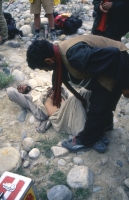 066_Bardumal Healing
066_Bardumal Healing
One of the porters suffered severe abdominal pains; we knew no diagnosis, and therefore no therapy. The sirdar showed us how to do in such cases: Index-finger in the umbilicus and walk around the patient clock-wise. It worked for half an hour: porter and load had to be carried!
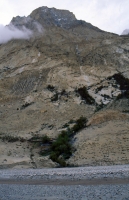 067_Payu
067_Payu
Payu (3807 m) is the last camp-site before the glacier. It consists basically of a small oasis (some 150 by 100 m) along a small stream, with about 150 small trees, which can hide about 200 porters and a couple of tents inside.
 068_Payu Camp
068_Payu Camp
Expeditions have to cook with fuel-burners. Years ago an expedition burnt almost all wood on Payu, leaving it bare. The red roof is of the lemonade-shop!
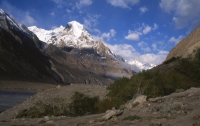 069_Payu
069_Payu
Payu from aside. Right behind me are the latrines: in the middle of a ground covered by human (fecal) droppings! It stinks.
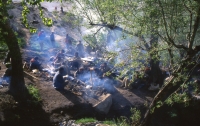 071_Payu Camp
071_Payu Camp
Porters sleep huddled together, under a large plastic foil. They still prefer cooking on wood. They will try to find (or cut) wood to cook on, they would probably leave Payu bare again.


